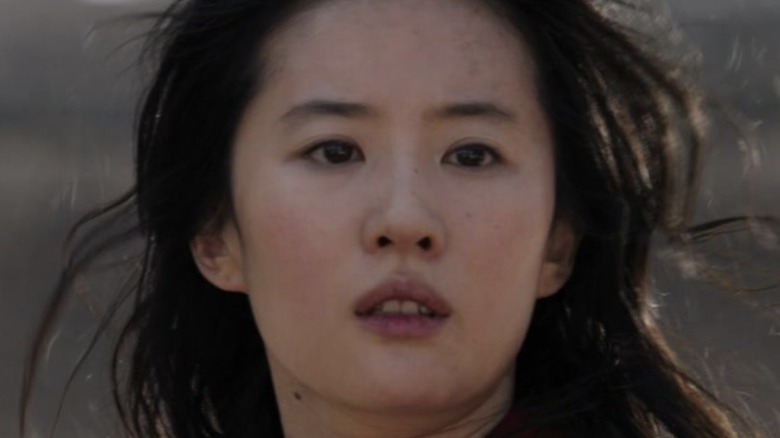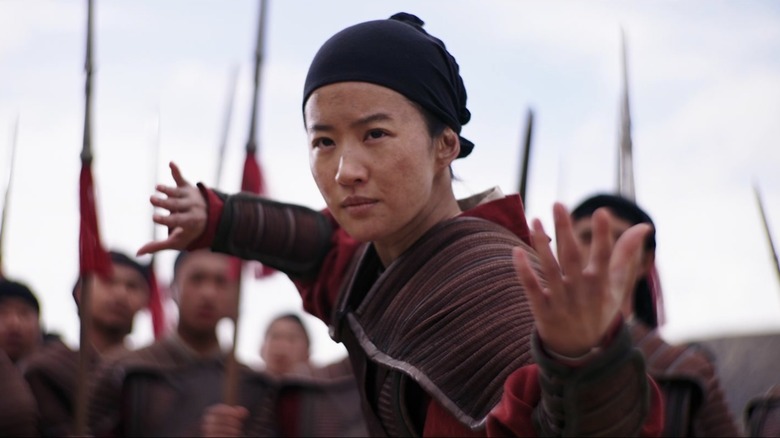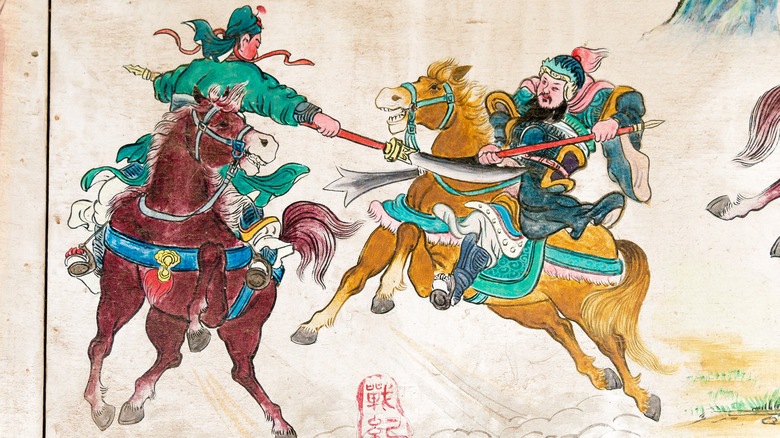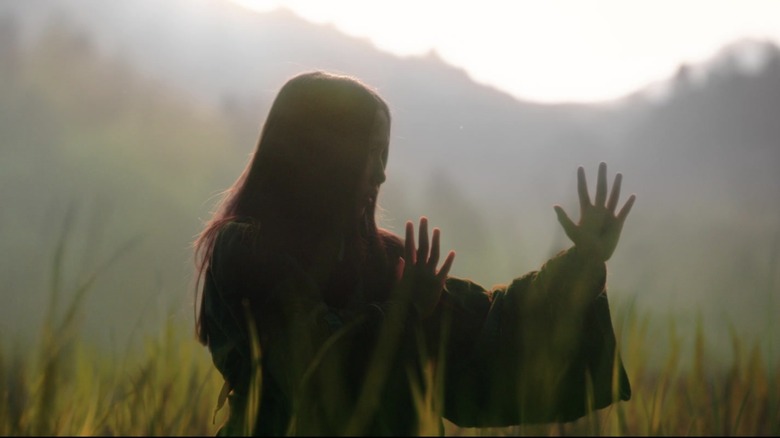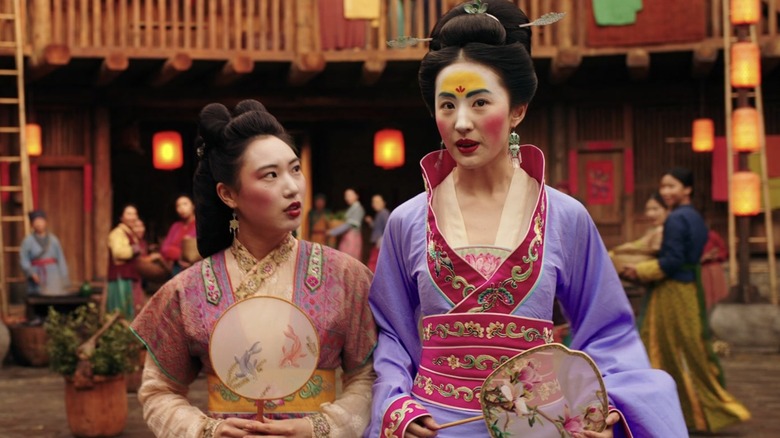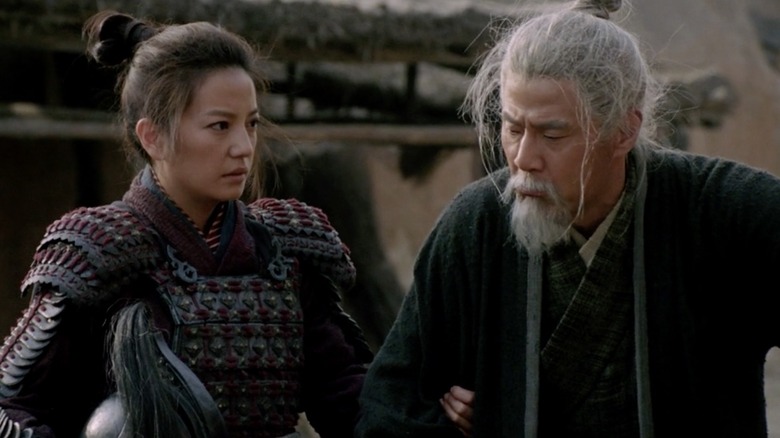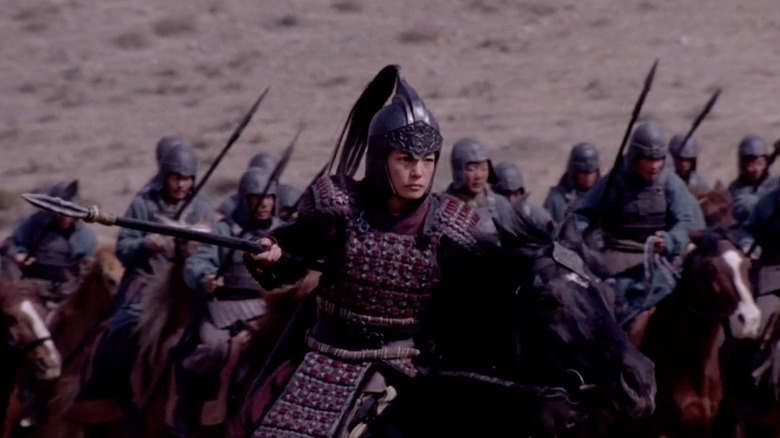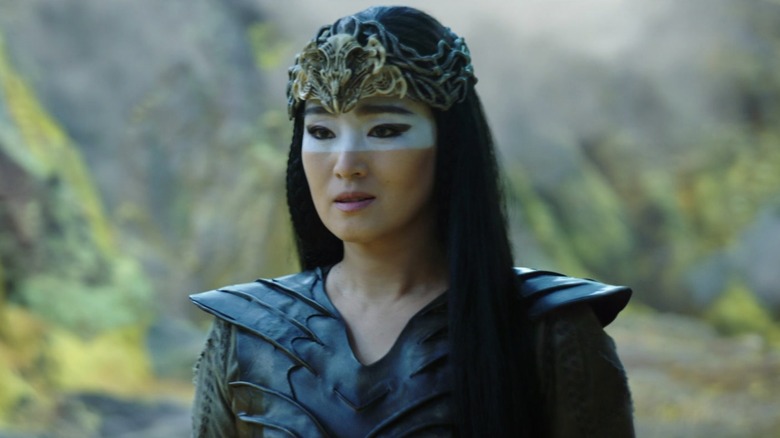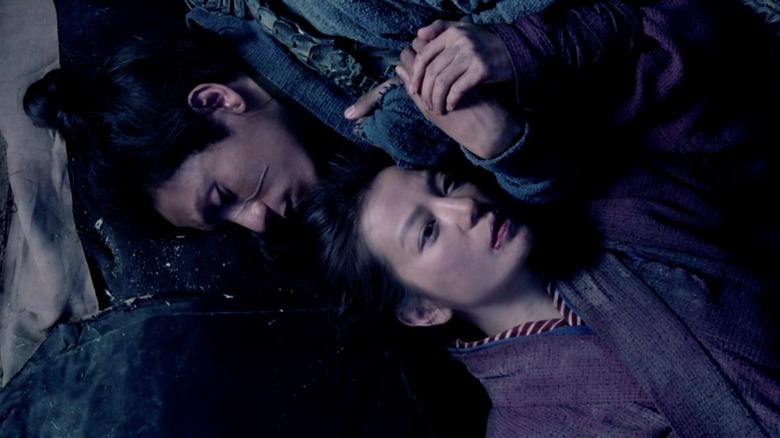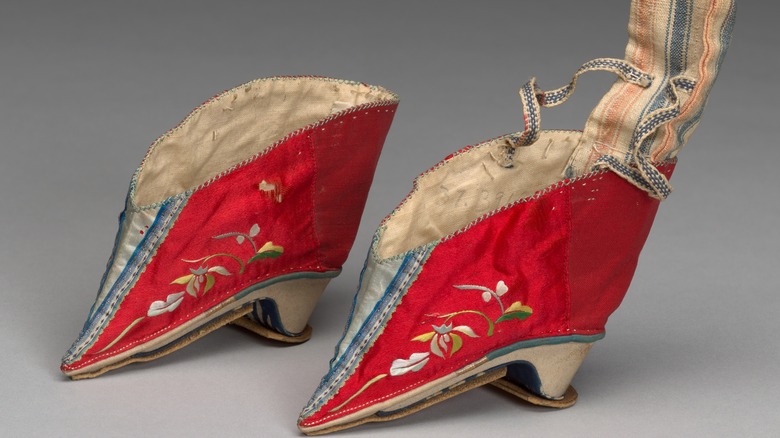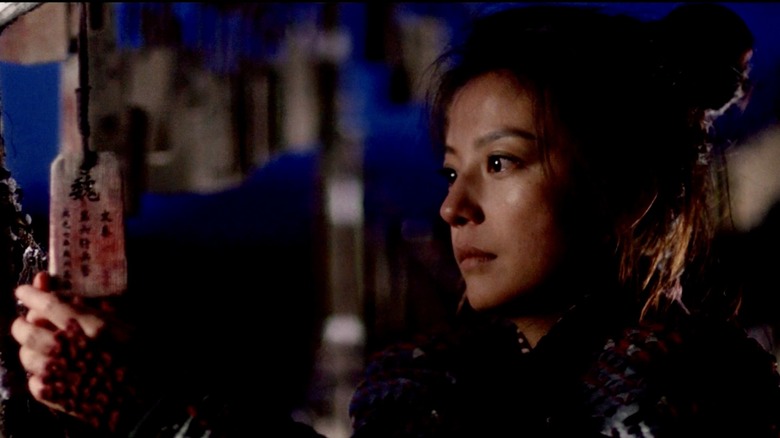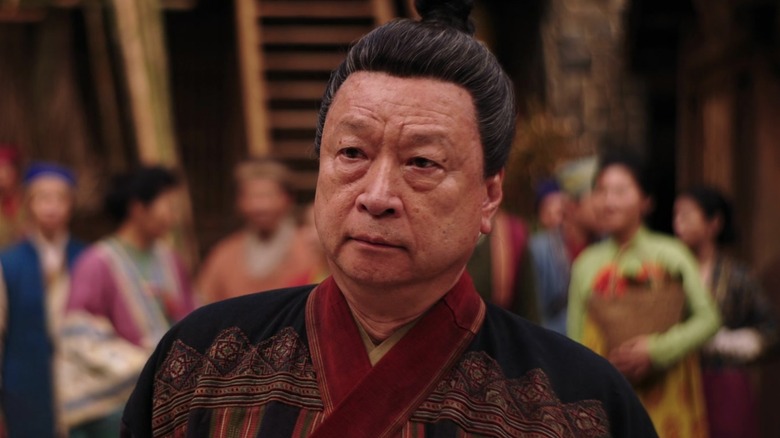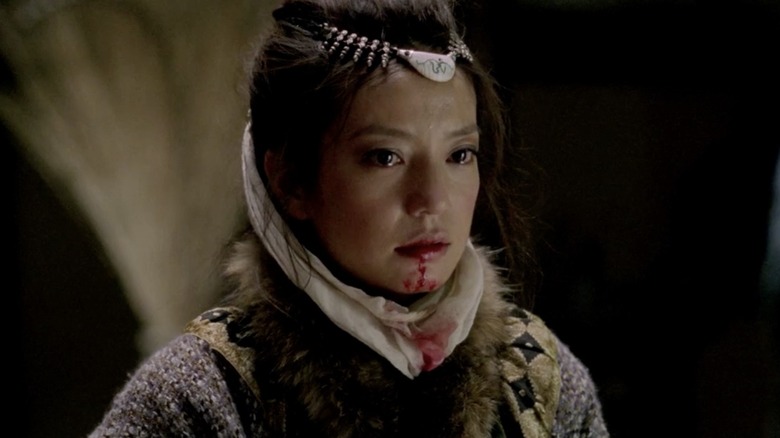The Dark History Of Mulan
Outside of Asia, many learned of the legendary heroine Mulan from Disney's animated version in 1998. This adaptation was made for children and avoided many of the darker themes of the Mulan legends by adding a funny dragon named Mushu (Eddie Murphy), a love story with General Li Shang (BD Wong), and musical numbers. Disney's "Mulan" is a family-friendly story of triumph that was popular in the West, but as reported by Vox, "China had a lukewarm reaction to Disney's animated Mulan," largely due to how much it differed from the Chinese legends.
Disney's 2020 live-action version of "Mulan" is more complex. It delves into gender roles in Ancient China, concepts like chi (life force), and cultural fears of women who defied conventions. "Mulan" also explores supernatural elements, including a mythical phoenix watching over Mulan. In some ways, this iteration of the Mulan story was a more faithful depiction of the Chinese folktales, although it received criticism for lacking historical accuracy (per Time).
Meanwhile, the Chinese-language film, "Mulan: Rise of a Warrior" is a historical drama depicting the brutality of war and is the most faithful to the traditional folktales from China. As impressive as Mulan (Wei Zhao) is as a warrior, this version of the legend is the bleakest and most haunting of the three films. Despite this dark mood, the film still avoids some of the grimmest Mulan legends. Join us as we explore the dark history of Mulan and the story elements these movies left out.
It is unlikely Mulan was a historical figure
According to Time Magazine, Mulan may not have ever been a real person. The earliest references to Mulan are in "The Ballad of Mulan," a folk song from the Northern Wei region during the 4th or 5th-century. The first Mulan from "The Ballad of Mulan" was likely a Tuoba woman from a tribe who were once nomadic before settling in Northern China. This ballad reflected the venerated status and relative freedom women had in this nomadic culture.
One of the clear indicators the Mulan legend originated during the Northern Wei dynasty is the leader in this ballad is called a khan rather than an emperor. Ballads were typically inspirational stories, not historical accounts, suggesting Mulan was a fictional character rather than a historical figure. Still, we can't entirely dismiss the possibility, when there are women from more recent historical records like Princess Zhao of Pingyang, who helped raise an army of rebels to help her father establish the Tang dynasty (per ATI).
Although it is doubtful the Mulan legends are based upon a real woman, her legend has left its mark on Chinese literature and films and captured the popular imagination in the west. Mulan has also made her mark on martial arts. Mulan Hua Ja Quan incorporates Kung Fu and other martial arts with tai chi and dance (per World History).
The Legend of Mulan has been retold for over 1000 years
Legends of Mulan came from an oral tradition as a folk ballad, "The Ballad of Mulan." This story is set in the Northern Wei dynasty and was first written in poem form in the 6th century in "Musical Records of Old and New," but this original text has been lost. Sanping Chen, an author and scholar, told Time, "Anything not contained in this original poem has been made up by much later authors and cannot be historically substantiated."
"The Ballad of Mulan" was compiled into an anthology, "Music Bureau Collection," by Guo Maoqian during the 11th or 12th century gaining a wider audience. Guo Maoqian cites "Musical Records of Old and New" as his source (per ATI). The legend was later adapted into a play, "The Female Mulan Joins the Army in Place of Her Father" during the Ming dynasty by Xu Wei.
According to ATI, this play is the version of the story that informs many of the later adaptations. For example, Wei's play was the inspiration for the novel, "The Historical Romance of the Sui and Tang," written by Chu Renhuo in the 17th century. According to World History, this version of the Mulan legend was very popular but also included new story elements. Other modern adaptations from the 1800s brought new ideas and melodrama to the ancient folktale. In 1939, Mulan hit the silver screen in China in "Mulan Joins the Army" where she was a nationalist fighting against Japanese occupation.
Mulan trained in martial arts before she ran away to join the army
In the animated Disney movie, Mulan runs away to join the army in her father's place disguised as a boy, but her fighting skills manifest miraculously during training. Although Mulan is depicted as head-strong and determined, she doesn't have any training as a fighter before joining the Imperial Army to fight the Huns.
The live-action Disney film depicts Mulan being trained in martial arts by her father as a child. She has a natural ability bordering on the supernatural, something that is regarded with trepidation in her village. This depiction of her martial arts skill being linked to sorcery or the supernatural echoes "The Story of the Loyal, Filial, and Heroic Mulan," also known as "The Complete Account of Extraordinary Mulan," which was written in the 1800s. In this imaginative version of the Mulan legend, her grandfather taught her the dark arts before she joined the army (per World History).
In the opening scenes of "Mulan: Rise of a Warrior," we learn Mulan trained in martial arts in her village before she takes her father's armor, horse, and sword to join the army in his place. This depiction is congruent with the 16th-century play by the Ming dynasty playwright Xu Wei. Xiaosu Sun asserts in their Master's thesis, "This suggests that in non-Han Wei culture, it may have been common practice that military families in the North train their daughters in the arts of war."
In traditional Mulan folk tales, Mulan is the eldest daughter
In modern films, Mulan is depicted as an only child, but in the Disney live-action film, she has a younger sister. In the original poem and the following folktales, Mulan is the eldest daughter, having a younger brother who is too young to fight. Xiaosu Sun says in their Master's thesis, "What makes Mulan perfectly fit into the Chinese gender system is her female virtue. Mulan's father is too old to fight, and her young sister and brother are too young to go. Because of love and piety to the family, Mulan takes on this taxing task." Mulan's feminine virtue is then proven in the 16th-century play when she returns home and accepts an arranged marriage (per Vox).
While Mulan's filial devotion to her father is also her motivation in the Disney adaptations, this is only true on the surface. The 1998 animated film focuses on how Mulan is a tomboy and doesn't fit into the strict gender norms of her culture — gender roles that appear to be more strict than those of the nomadic culture the original ballad sprung from (per Vox).
In Disney's live-action "Mulan" film, the title heroine might initially leave to protect her father, who would surely not survive another war, but her own desires to prove herself worthy despite being different also motivated her. The major departure of the live-action film is that despite returning home after saving the emperor, the film's feminist ending suggests Mulan still might accept a position in the Imperial Guard.
In the ancient legends, Mulan tells her parents she is going to fight in her father's place
Mulan runs away to fight in her father's place without telling her family in the Disney films. In those versions of the story, she knows they will try to stop her so she leaves in the night while her family sleeps, leaving behind her comb in place of the scroll commanding her father to appear to join the Imperial Army. In these Disney interpretations, they do not go after her and tell no one because the punishment for impersonating a man to join the army would be death.
In the ancient ballad, however, Mulan told her parents she wanted to fight in her father's place, and her parents respected her sacrifice and decision. In the 6th stanza of the poem, Mulan says goodbye to her family, "At dawn, she bids farewell to Father and Mother... She doesn't hear the sound of Father and Mother calling for Daughter."
In Xu Wei's play from the Ming dynasty in the 16th century, Mulan also tells her family of her wish to fight in her father's place, saying, "When I was a child, I was physically strong and pretty clever too. I used to study both classic literature and martial arts with my father. Now is the time for me to repay him" (per Xiaosu Sun). As Xiaosu Sun argues in their Master's thesis, this act may seem subversive on the surface but is rooted in filial piety, making Mulan a heroine.
Mulan posed as a man in the army for 10 to 12 years
In both Disney films, Mulan joins the army in the place of her father and soon proves herself heroic in battle. In the animated film, Mulan is discovered to be a woman after she is injured in battle, but in Disney's live-action film Mulan reveals herself to be a woman by riding into battle with her hair down. In both films, she is temporarily shunned for her dishonesty but ultimately recognized as a heroine by the emperor.
In the ancient poem, Mulan "goes ten thousand miles in the war machine," fighting as a man in the army for 10 years and rising in the ranks before she asks for a camel to take her to her village. It is only after returning to her village that she dresses as a woman, wearing yellow face powder, and reveals she is a woman to her comrades who fought at her side. They respond with surprise rather than anger.
In later versions of the Mulan legend, she fights in the army for 12 years before returning to her village. This timetable is reflected in the Chinese-language film, "Mulan: Rise of a Warrior." In this historical epic, Mulan fights in the army, first as a soldier and then as a general. Two of her fellow soldiers keep her secret, and Mulan only reveals her gender to the emperor when she wants to return home after over a decade of service.
In some tales, another warrior woman captures Mulan
Although this is not depicted in any of the films we've discussed, in the novel "The Historical Romance of the Sui and Tang" by Chu Renhuo, another female warrior named Dou Xianniang captures Mulan. This powerful woman admires Mulan's courage and, rather than imprisoning or killing Mulan, Dou Xianniang makes Mulan her assistant.
The Disney live-action "Mulan" features a female warrior, also named Xianniang (Gong Li) who fights with the invading barbarians. The warriors who fight with Xianniang fear her and call her a witch. Despite being on different sides, Mulan and Xianniang form a bond because they are much the same. Vox argues Xianniang functions as a warning to Mulan of what could become of her if she diverges from a noble path. The supernatural source of Mulan and Xianniang's power and skill also harkens back to the magically infused "The Complete Account of Extraordinary Mulan" from the 19th century (per World History).
In "Mulan: Rise of a Warrior," Mulan conspires with the Rouran princess (Angel Liu), the sister of their enemy, to murder her brother and form an alliance, promoting peace between their people by having the princess marry one of the emperor's sons. This storyline echoes the theme of female bonds and friendship from Chinese literature that was inspired by the early Mulan folklore. This Chinese film also leans into the tragedy of later iterations because the Prince she arranges for the Rouran princess to marry is the man Mulan loves.
In some legends, a fellow soldier discovers Mulan's secret
The earliest Mulan folk tales do not include a love story. It was the play "The Female Mulan" by Xu Wei that first introduced a love interest for Mulan. He achieved this when she consented to an arranged marriage after returning to her village (per World History). We see this reflected in Mulan's love interest in Disney's animated film and in the sequel "Mulan II" where she becomes engaged to Li Shang.
Mulan is exposed as a woman after being injured in the Disney animated movie, something that does not happen in traditional Chinese folktales. In Disney's live-action "Mulan," it is Mulan herself who reveals who she is and this is true to the traditional folktales. In "The Complete Account of Extraordinary Mulan," a fellow soldier named Li Jing realizes Mulan is a woman, but he keeps her secret (per World History). According to Ancient Origins, in some versions, she falls in love with the soldier.
We see this tragic love story played out in the film, "Mulan: Rise of a warrior." Wentai (Kun Chen) discovers Mulan is a woman, and he keeps her secret. They fight by each other's sides for years and fall in love. Their love is chaste, and they do not marry after Mulan reveals herself to be a woman. Mulan sacrifices her love and happiness by arranging for Wentai to marry the Rouran princess to establish peace between the warring cultures.
In a 16th-century play, Mulan removes her foot bindings to join the army
In the late Ming dynasty, Xu Wei's play "The Female Mulan..." Mulan removes her foot bindings to become a warrior for the army. While foot binding wasn't popular with the Xianbei tribe during the Northern Wei period where the Mulan legend originated, and where this play was set, it was popular amongst the ancient Chinese elite in the Ming dynasty who would have seen or read this play (per Time).
Foot binding was a painful custom that persisted amongst Chinese women for 1000 years. The practice is rumored to have been inspired by a court dancer, Yao Niang, in the 10th century. Foot binding became a status symbol during the Han dynasty amongst ladies in the royal court. A small foot was the epitome of feminine beauty, thus the practice took on "erotic overtones" and was a distinguishing characteristic tied to a woman's marriageability (per Smithsonian Magazine).
In this play, Mulan frets about removing her foot bindings, wondering, "I will still get married after I come back. What will I do then?" This was an anxiety women during Xu Wei's period would relate to. It also asserts how closely marriageability was tied to feminine virtues and arbitrary beauty standards (per Vox). Although this detail of foot binding was popularized after the original ballad was composed, it is incorporated into a newer edition of the folktale because the legend was altered to represent the values of each culture that revives this ancient story.
Mulan is depicted as being haunted by her experiences in battle
The two Disney adaptations many of us are familiar with have an overwhelmingly upbeat attitude and embrace Mulan's story as one of triumph over adversity, ending with Mulan reuniting with her family as a celebrated heroine. Some of the later Chinese adaptations of these folktales have a much darker ending for our heroine. Rather than living as a venerated general, Mulan retires to her village where she feels isolated and is haunted by her experiences at war (per Ancient Origins).
The film "Mulan: Rise of a Warrior" embraces this darker vibe and explores her 12 years in the army as a time steeped in brutality. Although she reveals she is a woman at the end of her service, requesting to go home to her family, Mulan seems more resigned than triumphant. She is duty-driven rather than virtuous. In this version of the Mulan folktale, she gives up the man she loves, Wentai, in an arranged marriage. Mulan regards herself as a wounded woman destined to live out her remaining years in isolation, not as a heroine whose story will be retold for 1000 years.
Some Mulan legends do not end in a joyous family reunion
Mulan's father is still alive when she returns home in all the film versions we have discussed. Although Disney gets a bad reputation for forcing a happy ending into every story, these filmmakers actually borrowed this happy ending from the earliest version of the ballad that ends with her reuniting with her family in her village. The playwright Xu Wei was the first to give Mulan the happy ending of a marriage, but some of the more modern Chinese interpretations of the tale lean into melodrama, ending in tragedy (per World History).
In "The Historical Romance of the Sui and Tang" by Chu Renhuo, Mulan is the daughter of a Turkish father and a Chinese mother, and she fights for the Khan in her father's place. When the war is over and Mulan is pardoned by the Emperor for fighting for the Turkish Kahn, Mulan returns to her home village only to learn from her younger sister, Youlan, that her father died while she was away at war, and her mother has remarried (per Xiaosu Sun's thesis). This certainly isn't the triumphant return modern audiences are used to.
Some Mulan legends end in tragedy when she takes her own life
In some legends, Mulan takes her own life. These melodramatic iterations began in the late Ming dynasty at the tail end of the 1600s. In "The Historical Romance of the Sui and Tang," by Chu Renhuo, Mulan returns home to learn her father has died, and her mother has remarried. After learning of her beauty and prowess as a warrior, the Turkish Kahn for whom she fought, summons her to be his concubine. Rather than suffer the humiliation of being a concubine, Mulan takes her own life (per Xiaosu Sun's thesis).
In another gruesome version of the Mulan legend, our heroine Mulan is slandered by someone who uses a prophecy to convince the emperor that Mulan will threaten his throne. To prove her loyalty to the emperor, Mulan cuts out her own heart, making herself a martyr. This version of the story is absolutely the most gruesome end for our brave heroine. In other versions, Mulan dies by suicide rather than live under foreign rule. She also dies in some versions of the story to avoid marriage (per Xiaosu Sun). Although we might think Hollywood's happy endings are trite and overdone, in the case of Mulan, the happy endings of modern films are true to the earliest versions of the Mulan folk tales of Ancient China.
If you or anyone you know is having suicidal thoughts, please call the National Suicide Prevention Lifeline at 1-800-273-TALK (8255).
